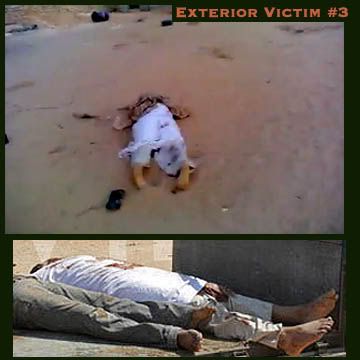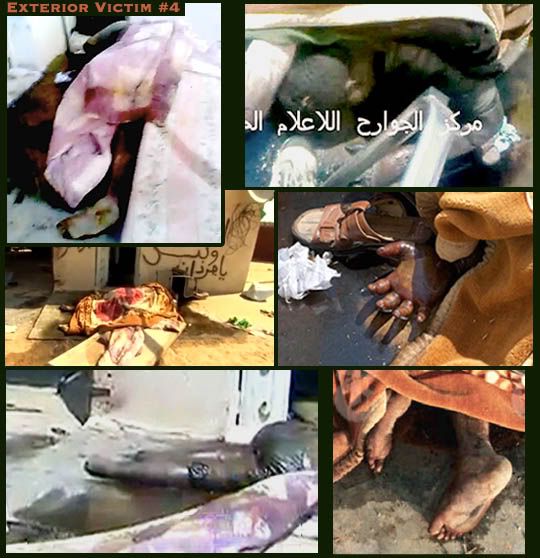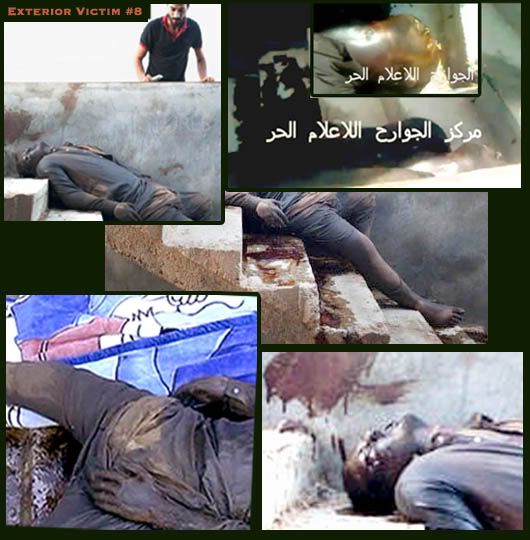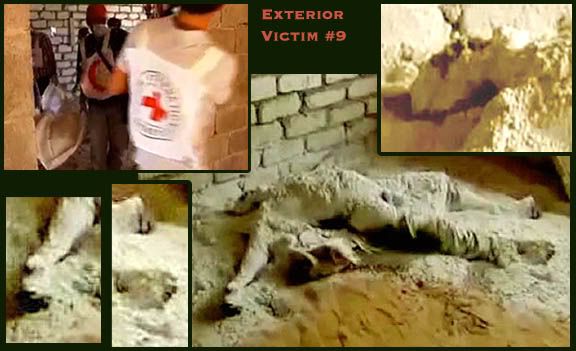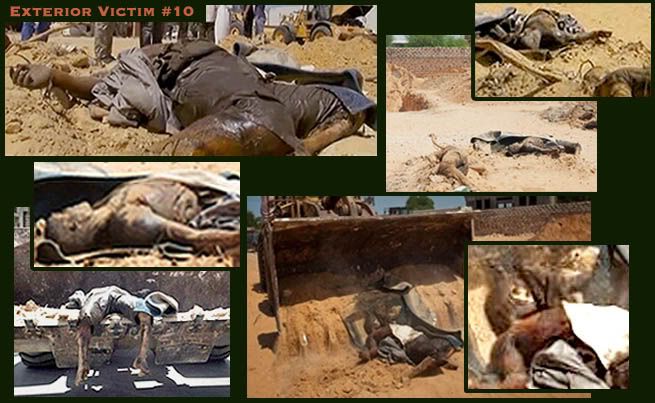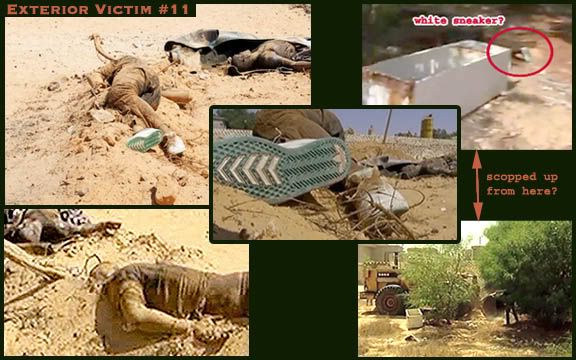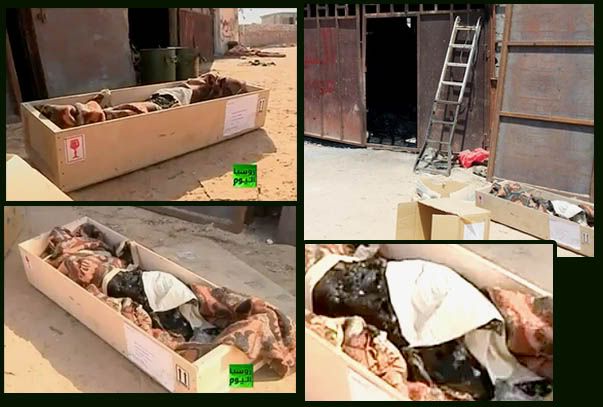Original Posting, November 15, 2011
Deleted for complete re-write, April 29
re-write complete May 3, 2012, last edits May 7
<< The Tripoli Massacres
<< The Khamis Brigade Shed Massacre
Those Not Anonymized by Fire
In addition to the 45 or so people charred to cinders within it, there were at least 32 bodies discovered immediately around the site of the Yarmouk massacre shed. These were either in or just outside the prison yard or across the street. There are eleven of these that have been photographed and can be placed and described, as they are below.
It’s not entirely certain they were killed by the same people, but the rebels are clear in blaming these killings as well on Gaddafi loyalists only. Considering the information on
racist rebel brutality up to this point, this is unlikely. These other bodies were left in the open but primarily un-burnt, and so had surface features like skin (mostly black African) and clothing (partially military) left intact.
These bodies were widely noted by journalists, counted in varying sub-sets, but given real thought and scrutiny by very few. Clemens Höges, describing the scene in the walled compound right around the central shed,
for Der Spiegel English, ventured some worthwhile observations:
An alternative explanation, however, would be that the rebels massacred their prisoners on Friday evening after the battle and tried to pin the crime on Gadhafi's forces. But on Saturday evening, one of the bodies lying outside was swarming with thousands of tiny maggots, which would be impossible if the man had only been killed the day before.
Some of the bodies (#4, #7) have visible maggots nearby in some images, and this does suggest death at least a day prior to the acknowledged rebel conquest. But there are, in fact, signs that the base was taken some days before the rebels acknowledge taking it, a subject discussed elsewhere (best
here). For this article we will consider it an open possibility and see what the evidence suggests. As Höges further noted:
There are a number of inconsistencies in the explanations about the Khellet Ferjan massacre. The four dead men outside the warehouse whose corpses were not burned appear to have been powerfully built, dark-skinned men, as far as can be judged after days in the Libyan heat. It is possible that they were soldiers who wanted to desert or did not want to be involved in the massacre. Ali Boukhatwa confirmed this version of events and also said that the soldiers had been tortured.
Boukhatwa, an all-knowing local from a few hundred feet away, is sure that the black soldiers defected, were tortured and then executed, by Gaddafi villains, and left un-buried and un-burnt before the racist rebel hordes ever screeched in there. That is one allegedly well-informed local. But not quite as well-informed or connected as “
Dr. Salem Rajab,” who pops up frequently in the exploration below.
The chattering so-called witnesses aside, here is whatwe can see about the eleven exterior victims, listed in order seen/left-right, etc. A map for reference:
The Three Removed Early
These three victims were seen in situ in
a video posted by Batruna, from late on the 26th, filmed about 8 pm by the dimming light of a recently set sun. These were removed from the scene about 10:00 AM on the 27th, laid on a flatbed truck and driven away, as seen in a sequence of three photographs taken by Seamus Murphy, VII images. [
1 -
2 -
3]
These were among the first news photos of the area, and the lighting, with moderate shadow length, suggests mid-morning, say 9:30 or 10:00 AM. The truck they're laid on was then driven away, and within an hour (about 11am) Stuart Ramsay of Sky News would be in the same exacts pot the first photo was shot from for the first news video, speaking to Dr. Salem al Farjani, pretending to be a witness Dr. Salem Rajab (he keeps popping up below). (See
an image here of the green "Gaddafi loyalist" graffiti added between takes, exactly after Murphy's one snapshot).
Clearly Sky News didn’t capture these bodies, and no one later did. Only to our knowledge that rebel video and those early photos.
Exterior Victim #1: The Man in the Truck
This victim is a mid-toned male, a bit overweight and perhaps middle-aged, in bloodied underclothes, with what seems to be
torture to the arms, a slit throat, and at one point a charred face. His brutalized body was seen being loaded from a police transport truck (paddy wagon) to flatbed truck in the Murphy photos, after the other two bodies were already placed. As the one visible victim with clear signs of burning, he stands out; his face is quite gruesome to behold there, crusted charcoal black with orange peeking through, what looks like blue-tinged remnants of melted eyeballs. His shoulders look blistered and cracked, as if heated but shielded from flame. A burning tire “necklace” seems like a good explanation for all of this.
 |
Small view for those who don't need the
graphic images large. For the rest,
right-click, new window |
His body was also visible splayed out alone inside the one truck the night of the 26th, about 14 hours before that removal. He’s laid flat, face-up, amidst a pool of blood and an overturned bowl. The dim view and low resolution make it hard to be certain, but the skin of his face and shoulder seem smooth and normal colored then, not burnt at all. It would seem
someone set that fire in the hours before Murphy’s views. Rebel forces, not Gaddafi loyalists, were in charge at that time.
This victim’s arms show signs of torture in both views, bruised, bloodied, perhaps misshapen, an apparent slice in the right forearm. The first view shows much blood on his chest and the shoulder straps of his shirt, centered around the neck area with darkness of a wound or of clotted blood visible there. A slit throat, looking like an Islamist execution method, might help explain the fire, set around his neck to melt and char the skin, and obscure that clue. It didn’t work; Murphy’s photo seems to show
a serious slice across the victim’s lower throat. (see bottom, middle).
They might also have wanted to hide the face of someone they didn’t want seen as one of the victims. That effort seems to have fared better. Using fire to erase clues is supposed to be the idea that led to all those bodies being charred blank inside the massacre shed? But whoever victim #1 was and whoever killed him, it seems
someone on the rebel side tried to use fire to destroy the evidence of it.
Exterior Victim #2: The Crawler
This victim is on the left among the two first bodies laid across the truck bed. Situated face-up, we see he could almost pass for a rebel fighter – bearded, stocky, in clothing both civilian and yet potentially militant. In the August 26 video, it appears as if he died crawling out of the massacre shed, only making it a few yards before expiring with his head resting against his forearm.
When we see his underside in the morning, it shows massive bleeding of the abdominal area, and unclear issue of the left side, including chest. He was possibly just shot, or perhaps subjected to some broad trauma like being crushed beneath the tires of a heavy vehicle. He might have died from Pneumothorax from internal injuries, explaining the sudden death from suffocation. He might have been dropped in the smoldering shed as he was dying, just to get a crawler for dramatic effect.
Despite being smeared in dirt from crawling or dragging, his anguished face is relatively clear and would likely be recognizable to family, who may or may not be willing to speak up.
Exterior Victim #3: The Runner
This is a mid-tone male, apparently shot while running from the shed area to the gate, judging by the sandal flung off his foot nearby. Dressed in a white shalwar kameez outfit and sprawled out face-down, his body is uncovered except apparently the head and shoulders. There’s no visible blood in the rebel video, but it just pans over him from a distance. Seamus Murphy’s photo shows widespread injuries and bleeding beneath the clothes, especially the left side, from chest to knee. His head is never visible.
Journalist Janine DiGiovani
wrote after her visit “There are places in the world, like Srebrenica in Bosnia, like Hama in Syria, where the ghosts of death linger long after the event. … the field is scattered with objects the prisoners left behind—a single sandal, perhaps lost while fleeing.” She might refer to this same sandal, and the video confirms her impression, with the one sandal near his bare feet, the other perhaps being the dark shape about six feet away, or perhaps missing.
The Mattress Victims
The next three victims were killed on three mattresses together at the shed’s east end. They're the only bodies covered with blankets in the customary gesture, and that only because they had their own, apparently caught sleeping beneath them. They seem to be wearing bedclothes, and their shoes are removed nearby. DiGiovanni noted “a plastic bag of toiletries hanging on a nail in the wall—but otherwise the place is eerily silent.” This was outside the shed, where soldiers slept, right above a pair of black sneakers, best shown in
a high-res photo (allegedly of rebel fighters) by Louafi Larbi.
Military uniforms hang alongside green flags or lay nearby, now partially tossed across their bodies as if to clarify that these were Gaddafi army fighters. Two of them are black men. Our local Salem
told French paper Liberation they were in fact soldiers, “who refused to participate in the killing.” Mimicking the scene, as if he had seen it, he continued “and the mercenaries killed them on the spot.”
Perhaps the alleged final conversation was something like this:
Officer: “Soldiers, it’s time to kill. You, take this Kalashnikov, you these grenades. You, this other gun, and watch for escapees.”
Soldier 1: “Come on, you just woke us up.”
Soldier 2: “Yeah, I’m not ready to get up yet. Can you let us lay here just five more minutes?”
Officer: “You are refusing? Mercenary, kill them all.”
Mindless African slave: (Bang bang, and also torture sounds, order unclear)
These three more killed for refusing were heroes, like so many others found in Free Libya from February onwards, left to rot by their rebel beneficiaries.
These are numbered starting from the gate, as
Martin Fricker noted for the UK Daily Mirror “the first thing we saw was the corpse of a Gaddafi loyalist, his decomposing remains partially covered by a blanket. Nearby there were two more bodies, one with his hands and feet bound.”
Exterior Victim #4: Outside the Guard House
This first victim you'd see is laid just outside the small shack attached to the massacre shed, face down and hidden beneath an especially colorful floral blanket, at least on the 27th and after. On the night of the 26th, it was a pink one with squares (upper left, Batruna video), still there later under the orange blanket someone felt was warranted. Only this victim’s bare feet are usually visible, but sometimes his right hand, left arm, once his head, and once even his uncovered lower body was seen. All glimpses suggest with near-certainty, by skin color and hair type, this is a black man of African descent.
The Aljwahr Free Media video shows the back of his head, with a likely bullet hole near the top, and his bent left forearm, decaying. The arms position and being off the mattress suggests he may have been face-up at one point, then rolled over on his right side. If so, it was prior to the first known view (upper left). The lower right view of the victim's feet is by
Moises Saman, NYT (a
black and white version, and
an almost identical view by Bryan Denton - thanks Felix for the links). These seem to show injuries on the right foot, but in different spots, so likely an illusion of artifacts. But the uncovered view (lower left,
TV1 video (image stitched together for widest/best view possible, around the TV1 logo) reveals he’s dressed only in underwear shorts, and displays with less ambiguity a painful-looking wound at the tender spot behind the right knee.
A massive pool of blood, watered down with rain or whatever, surrounds and soaks the body, its mattress and the ground. The bloody water pooled along the shack’s wall, along with a very swollen right hand, can be seen in an unusual
photograph by Szlankó Bálint (right, middle). A swollen hand can suggest prolonged binding, but the wrists aren’t visible.
Bálint’s images were taken on August 28, by the established visual chronology, although mis-labeled as Aug. 29 (the posting date, likely). There’s also a sandal shown and maggots - large-full-grown, ready to pupate maggots. These would be the first-hatched, the pioneers. The vast majority would be smaller and grubbing away in the thousands beneath the blanket. This is a timeline clue the CIWCL cannot read precisely, but an expert could, and it would greatly narrow down the date of killing. I think it was around the 24th, give or take.
Exterior Victim #5: Bound Feet
Just past the alleged guard shack is a covered but open area between it and the massacre shed. There, under a tin roof, the other two mattress victims were laid with their own beds, with #5 the more visible by far. His body is laid face-down and covered with a green blanket so only his lower legs are seen, clad in blue sweatpants or pajama pants. His feet, decaying, swollen, and light-skinned, are tied together with a long stretch of green rope. Yuri Kozyrev took
a photo (unused here) captioned “the dead body of a member of Gaddafi's forces lies on a mattress...”
These feet are shown frequently in the news videos, the rest of him not at all. The two amateur videos from the 27th do pan across the other end, giving us a faint glimpse of a head shaded under the blanket. It’s round, possibly bald, and reddish in color, at the moment seen. Clemens Höges had described the scene for Der Spiegel “Next to the warehouse, under a corrugated iron roof, lies a tied-up man who had been shot in the face.” He’s face-down, and always covered, so this is a little puzzling. This victim was killed and/or bled massively across both mattresses. The striped one held his lower body. The checkered bed, where his upper body rotted unseen for days, had that end later collapse in decay, or something to that effect. (upper right)
The rope seems to have its knot moved around over time, and the length was tossed from the position of Aug. 26 (lower left) to the right side in all later images. What do the feet mean? Bound hands tend to suggest execution, as does removal of any footwear. But tied ankles are something that’s rarely seen in any other rebel/alleged-Gaddafi executions.The green color of it is, of course, supposed to suggest Gaddafi loyalists did the tying. It's quite likely from the swelling and abrasion that he was hanged upside down, but not apparently for very long. The mud on his left knee (lower right) suggests he was dragged a bit.
Exterior Victim #6: Facial Trauma
The third body a bit further in, rolled against the shed’s west wall of corrugated iron, and so less visible. His feet only are often visible, despite being laid face-up and not being fully covered like #5. While outsider cameras glossed over this corpse, two amateur Libyan videos pan right in on it, but in lower quality, showing the only visible face of the three mattress victims. It’s not pretty.
He’s clothed in some baggy bed-clothes, blood-soaked, half-covered with camouflage fatigues, what might be a mid-sized green flag, and a pastel-colored blanket. His skin tone is middling dark, and his face in close-up shows a wide-nostril African face, yellowing with decay for some reason. Clemens Höges had described “tied-up man who had been shot in the face,” as seen by him late on the27th. He does have a hole in his face, perhaps too big for an entry wound. It might be an exit wound after shot in back of head, or another kind of traumatic facial injury centered on the
obliterated left eye: surrounding tissue torn open and up, mid-face possibly pushed in, looking collapsed.
However, this body is not bound hand or foot in any images of the time he was there, the left arm hanging free against his mattress, and the right laid across his chest (this and his position suggest he was perhaps face down on the bed before, but was rolled over by someone curious. Höges apparently merged the two bodies into one: #5’s feet and #6’s face (specifying a second mattress victim out of two, "a few steps away.")
While no images show it so,
this body might have been bound at one point; the left wrist shows a curious advanced decay suggesting something like the super-tight plastic cuffs we see rebels put on Black men.
Three Peripheral Victims Seen in Situ
These outlying victims suggest action and a slight distance from the shed, and tend to be described by rebel witnesses as fellow escapees from the Gaddafi massacre. It might be silly for the dozens of exclusively light-skinned Arab escapees to claim the camo-clad black men killed at their posts as fellow prisoners and even family. But the following three brutalized black men in civilian clothes might all have been people who ran with them away from the grenades, depending who you ask.
Exterior Victim #7: The Man by the Toppled Wall
This clearly black-skinned man was found laying next to partially toppled low wall on the shed compound’s west end. He’s shown well in a Human Rights Watch photo of sunset on Aug. 27 (upper left here). [
with this article] A CBC photo by Derek Stoffel [
with article] shows a different angle, while
their video doesn’t show him at all (it mentions five bodies and shows four, but does include rebels or locals praying over a body in this spot at 2:09). Aljwahr Free
Media shows him fairly close-up (lower right), highlighting the burnt or
decaying shoulder, but leaving the details of his face just as mysterious as
the others. Maggots are visible on in his inner arm and on the blue tarp that
had apparently covered him until someone decided to expose another “Gaddafi
crime.”
He might well be an alleged escapee, per one witness anyway. “Omar” spoke to Physicians for Human Rights (their pseudonym), giving the same biographical details as Bashir Mohammed Al-Sedik/Germani, but a different escape story (And Bashir in return has a different story altogether from, but the same body as, a Mohammed Bahir - all explained
here). It seems like “Omar” was trying to explain exterior victim #7 with this story to PHR: "Another detainee attempted to escape by climbing through a hole in the warehouse wall, but guards immediately shot and killed him." The rest of the prisoners were beaten in punishment, and later a guard told Omar, whispering through the same hole, that
“the guards had left the man who had tried to escape to rot in the sun.” The hole in question is visible here (HRW's photo, upper middle of upper left image), not far from where this body was left rotting in the sun.
Exterior Victim #8: The Man on the Stairs
This black-skinned male of African descent, beefy build, bald-headed,
eyes apparently gouged out. He was apparently killed where he lays high on the stairs attached to the compound’s southwest corner. His baggy clothing, possibly bedclothes or a shalwar kameez, is soaked in blood almost uniformly, suggesting multiple shots, stabs, or whatever all over. Apparently of concern at time of his death was a seriously bloody injury somewhere around his groin. The CBC filmed this body
on the 28th, but only the lower half (bottom left image), with a baby blanket (not there earlier). This was covering most of his blood, not his body, with some cartoon character giving a thumbs-up sign. Aljwahr Free Media’s video sees him from above, as does CBC’s.
A photo by Tyler Hicks from the 27th (upper left) shows a Libyan man looking down at about the same angle. From the desiccation of the hands shown in the CBC video, it would seem he died at least two or three days prior to that - no later than the 26th and probably no earlier than the 24th.
This victim is the clearest alleged escapee of them all, with numerous sources suggesting this history. His body is best-seen in
a photo by Daniel Berehulak/Getty Images Europe (dated August 26, but app. from the following day, across the middle/background here and the lower right). The caption there reads in part: “the man is believed to be a detainee that had tried to escape, only to be shot by pro-Gaddafi loyalists." The CBC's explanation is about the same As reporter Susan Ormiston related from the other side of the wall from the victim, at 1:55 in the video:
Some of them tried to escape but failed. It appears a man ran from the building over to this white truck, was shot several times as he tried to scale this wall, and on the other side, he didn't make it.
Höges wrote for Der Spiegel how a body that might be this one “lies on a property directly next to the compound.” As described by witness Rafaii “One (escapee) got over the wall and into the neighboring property, where he was shot.”
None of this shooting in the back as he climbed a wall explains victim #8's eyes. The Berehulak photo shows they have something wrong with them, squeezed in pain and perhaps ruptured, although it’s ill-defined (there’s also a possible large, round hole in his right temple, but this could be a shadow artifact). His head part of that photo is cropped, blown-up, and enhanced, at lower right. Dominique Soguel for AFP had mentioned the three mattress victims laying around as "a fourth
eyeless corpse rapidly decomposed in the heat." Mr. Sabri Tabbal, self-described onetime shed prisoner, said of those less fortunate “some of them had their legs crushed, their
eyes gouged out, behavior that was …” something he couldn’t even put into words. (
video, 5:40) This body seems the most likely match, although no images are 100% clear. There is the huge blood smear near his head. This could be from anything, including his eye sockets, squirting out around some Misrata thug’s thumbs, possibly adding poignancy to the blanket motif.
Exterior Victim #9: The Man in the House
Australian ABC News’ correspondent, following on a late visit on August 29, reported “suddenly, there's a shout from the over the fence. Another body has been found. Quickly [the rebels] walk around to a house overlooking the base.” In a small dirt-floored room, the body was shown, already massively covered with lime powder. He was then removed in a body bag by Red Cross and Red Crescent people, it's said to an unnamed "city hospital" to be identified and reunited with his family. [
video]
This body seems solidly built, and possibly wearing the same baggy clothes as the man on the stairs. He lies on his back, limbs out as if pinned down. It might be that the extensive lime across the floor marks where he shed blood, which would be widely. It didn't soak in so well where his body meets the floor, and the surrounding red mud suggests major blood loss all over, again not unlike the stairs victim. Skin color is hard to make out beneath the pile of powder, but the fingers and toes at least tend to suggest that he’s a dark-skinned black man.
His face also shows possible blood from the eyes like the last victim, reddening the lime still (detail, upper right). From a distance, it looks frozen in a wide-mouthed scream, but on a closer look, it seems
his face is just caved in. The chin is there, but the space above it, including the nose at least, is just a gaping hole. The powder is poured on thick here, but it just fell into the crater rather than obscuring it. This looks like someone smashed in the face - and very deeply - with whatever was heavy, blunt, and handy.
The house in question is presumably among those just outside the south/west compound wall, and appears vacant and unfinished. It’s not clear which of those houses it might be, but the two westernmost ones seem more equipped with air conditioners and such, leaving the middle house more likely, or possibly the easternmost one (taller and so “overlooking the base.”)
The Christian Science Monitor seemed to have seen him as well (
Aug. 30 article) and decided "in an adjacent house lay another body, which
likely belonged to an escaped prisoner who had hidden there and died from his wounds."
In a Christian Scientist's mind, how long does it usually take for a man with his face crushed deep into his brain to die after fleeing the attack scene? From the above, and from the indoors locale, this is possibly the body that escapee Abdulrahim Ibrahim Bashir was trying to explain to Human Rights Watch.
He told them back on the 27th that "he escaped his detention in the warehouse unharmed together with Abdulsalam and Hussain, last name unknown, who were brothers from Zlitan.” The brothers were both wounded in the escape. Bashir's own account said:
After I escaped on August 23, I hid in a house outside the compound for three days, and saw that the guards were still there. [...] Two other detainees were wounded with me. [The rebels] took Abdulsalam from Zlitan to the hospital [after they arrived three days later], but his brother Hussain died in my arms in the house. I left his body inside the house...
What a strange decision no one amongst the brother Abdulsalam (Al-Ashour?) or the rescuers did anything to dissuade him from. A fellow heroic escapee, left to rot like... well, like this guy. He was left like the man who climbed out the hole, but this time it was the rebel/survivors being negligent. Also, there is no loving embrace evident in this corpse's death pose. But as an ridiculously alleged escapee, he shares yet another similarity with the brutalized man on the stairs.
Dozer Deliveries
The last two bodies were dumped in the prison yard mid-day on the 28th after being brought in by earth-mover/bulldozer. One was seen being dumped, the other being scooped up. Neither was in the yard prior, and it’snot clear what having them there added except spice and horror. They and their surroundings are seen best together in
a photo by Szlankó Bálint.
Exterior Victim #10: Missing Face
This, again, appears to be a well-built black male, in disarrayed civilian clothes, black shorts and white short torn away, exposing his chest. The flesh of his face and lower right shin stripped away, presumably by feral dogs. Various views of the body laying here were captured by the CBC’s cameras, as well as the Bálint photo. His left leg shows advanced decay (CBC view, upper left), and has likely dead for more at least three days
Before that, body #10 was seen in a Yuri Kozyrev photo (
Iranian re-post) dangling from the earth-mover's shovel driving just outside the compound’s southwest corner before entering the prison yard (lower left). There are three pirated Chinese photographs, one stamped as from Life, showing this same body, in greater resolution, being dumped into this precise spot and posture it would later be seen in. In sequence:
1 -
2 -
3 These are apparently shot mid-day on the 28th, by
someone with Getty Images (possibly Daniel Berehulak).
The first two let us see his dangling legs and clarify that his left shin is stripped of flesh, and the third image allows us an unusual brief glimpse of his head, enhanced at lower right. The tops and sides seem to be covered with skin, but his face itself seems to be gone. Literally, a skeleton's eye and nose socket remain, clean white bone. It looks strange. Other views like middle left (Bálint) fail to confirm this, but are consistent. His head is turned, and his face seems to just stop – no hint of the nose, cheeks, etc. that there should be.
Another anomaly seen in that middle left image is the apparent long, deep slices all over the upper body. Ineffective predation, torture, or something else? The tissue discoloration around them is also hinted in the Getty dumping photos, perhaps lightening/yellowing with decay along those injury lines.
Exterior Victim #11: White Sneakers
Another body only appearing in the yard on the 28th, was seen on a pile of dirt next to body #10, apparently dumped later and unseen. This was a well-built light-skinned male, app. bald-headed, potentially militant. He wore western civilian clothes, slacks and a t-shirt, and was the only one of the exterior victims clearly shod, in white Adidas sneakers. The back of his head is visible, but not his face, being completely buried in the dirt – perhaps for being eaten away like #10’s. Both exposed arms look unharmed, however. There’s no visible decay, suggesting possibly a later death than the others.
CBC filmed this one laid out, besides Bálint’s photo. What might be the same body was seen earlier in the day
by Channel 4, near a refrigerator in a copse of trees (upper right). The location seems to be just outside the compound, across the wall from a tall crane, which was at the south end. Therefore, it’s in the small courtyard (see map).
A Hungarian video shows a body there being scooped up by a bulldozer (lower right), and a tree root of some size juts out of the dirt near his head.
An Outside Body that Doesn’t Count
On the morning of the 28th, a wooden shipping crate marked “fragile” appeared just outside the shed’s entrance and stayed there most of the day. Inside was an apparent corpse – a blackened torso partly exposed, but nothing visibly skeletal. It’s mostly wrapped unseen with in a colorful blanket, that almost suggests mattress victim #4. But that body is still laying in the background.
This seems to be one of the less-charred bodies removed from inside the shed. As a reporter for Liberation wrote (rough translation from French):
Six volunteers who had come from the cement plant adjacent to the barracks [are] driving two vehicles, slowing down the sides already lowered. They wear surgical masks, chanting "Allahu" and "Akbar," and begin to collect, hands in rubber gloves, a skull, a chest, a tibia and what they think is a fibula. They wrapped this in a sunflower motif blanket in a coffin which they then lifted together on their shoulders.
Why this corpse was removed early isn’t totally clear. Perhaps it was to illustrate that someone had recognized that as his brother’s charred body, and wanted it home for a proper Islamic burial. Despite the non-skeletal state of some torsos, all faces were reduced to skull, so this is highly unlikely to have really happened. Once it was past the cameras, perhaps they dumped in a ditch they would take the cameras to later…
Others Reported / Totals / Re-Burials / Open Questions
Anthony Loyd wrote in The Australian how “seven bodies - all of males in civilian clothing, killed by gunshots - lay around the yard, while three other corpses lay in nearby alleys.” Alex Thomson of Channel Four News (
Aug. 28 footage) said "we can't show any of it, but there are bodies all over this area, many with hands and feet tied prior, apparently, to execution." They did show the locations - a dirt alleyway, and as mentioned a copse of trees with what might be body #11 (see still, upper right in #11's grahphic). From this, it’s quite likely body #10 is also among these three or more, and its dog-eaten face might explain why they wouldn’t show it. Saad Basir, apparently there on the 28th, wrote in
his Warscapes account "prisoner transport vehicles were also present at the site, and some contained bodies."
Just from this we may have little adding to the eleven seen by the 29th, but all-in-all, by that same time, there were several further bodies reported. ABC’s AM program
on August 30 reported that
twenty bodies total had been found “outside the warehouse,” with a further twelve “across the road.” In a visit apparently on Monday the 29th, their interviewee “Salem Rajab,” no ordinary local, was able to say:
SALEM RAJAB: ... [F]or the process of identification in the future we put them in a special plastic and we put them in a grave here nearby in the corner.
ANNE BARKER: You buried them here?
SALEM RAJAB: Yes we buried them here.
The United Nations Human Rights Commission, in an
advance report of March 2, 2012, failed to mention the 12 but confirmed that “20 bodies lay outside on the ground with gunshot wounds.” The report adds that these corpses “were subsequently collected in body bags and
reburied at Sidi Hamed in Gargarish.” [UH, p.70] This might be after being dug up from where Salem said they were first interred, already bagged. A
mysterious grave of about 200 bodies was found in Gargarish, along the coast four miles from Tripoli, in early October. It’s unclear if these include the remains put there by rebels after this confusing game of musical graves.
Additional victims from the immediate surrounding areas are less clear, with no known images, and one text description. The Irish Times
ran a piece on September 6, a week after Barker reported a total of 32 bodies, per Dr. Salim. The report described another body found that day, across the road “in a government-owned concrete factory.”
A severed hand was found first, followed by the body. The corpse, which had swollen in the heat and was covered in maggots, had been wrapped in a blanket and buried in a pile of sand and rubble. Its fingers and legs showed signs of mutilation. A doctor at the scene named Ahmed Suweidy said the corpse also appeared to have been partly burnt. [IT]
The stench alerted locals, and “police officer Salah Smohem said he believed other bodies may be buried within the factory grounds. “The smell suggests there must be others.....” And if it was government-owned, in late August 2011, that could mean only one thing, right?
With this tortured corpse that suffered fire damage, we’re able to open and close our examination of the un-burnt dead on similar cases with reminders that whoever killed these people were cruel and did like to use fire to desecrate the bodies and complicate investigation.
There would be more discoveries, however vague. For example, two days after the find described above, one further small mass grave was found in an unspecified area of “the Yarmouk neighborhood.” On September 8, Moises Saman for the New York Times
photographed rebel exhuming the bodies of “four dead men alleged to have been killed by retreating Qaddafi forces as Tripoli fell to the rebels.” One body is invisible inside a blue-green plastic sheet, the rest still invisible in the ground.
The full number of dead in that area, what was done with their bodies, who they had really belonged to, and who had really killed them all remain unsettled. Always there were bodies missing but surely nearby, an uncertain but sizeable number of them. They filled the gap between the 150 or more prisoners and the 4-10-50 or so visible bodies. Dr. Salem, once again, gave us this break-down:
There are about 65 bodies in all either in the barn or yard," said Dr Salem, a local resident. "But we know for a fact that there were more than 150 prisoners in the barn when the firing started and that only about ten escaped [25-50 now]. What has been done with the other bodies?"
There’s been talk of the remaining bodies dug up from a Gaddafi mass grave, before being re-buried elsewhere, but this has never been shown happening like it probably would if it had happened. Bodies we have reports or visual confirmation for are scattered, but adding up. Just sticking with these, we have:
About 45 in the shed, 32 un-burnt around and across the road, the severed-hand guy, the four dug up on the 6th, and
the 22 at the Yarmouk mosque dump nearby.
45+32+5+22 = 104
And 104 is a death toll curiously close to the number of suspected rebel civilians and/or mutinous soldiers now accepted accepted as killed - 106. A.M. Haleem’s 180 dead, Amr-Dau Algala’s sixty, all the 100-150 reports, brothers and friends and sons of the inconsistent white-skinned likely fakers analyzed
here - in the end was the real number simply the total of the mysterious dozens in the shed plus the racist torture-executions described above?
If so, what ever happened to the remainder of the 140-150 grenade-blasted "prisoners"
they had an explanation for by 6 am on the 24th?




